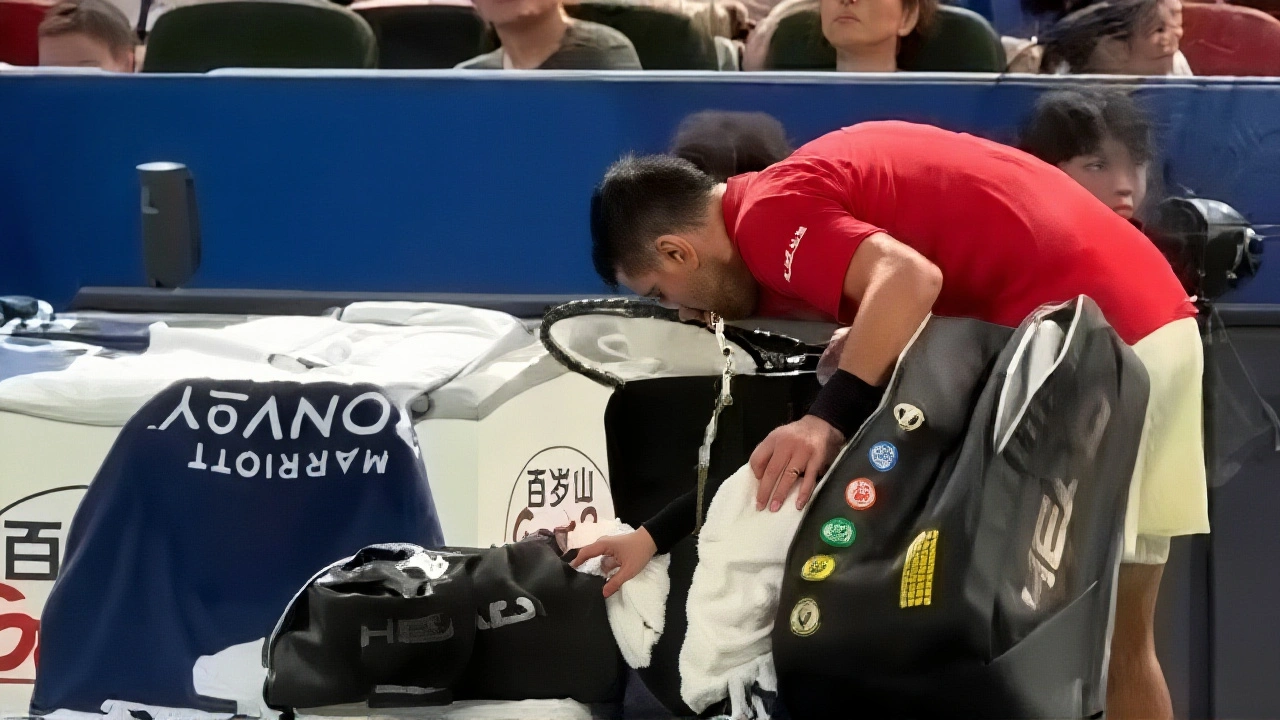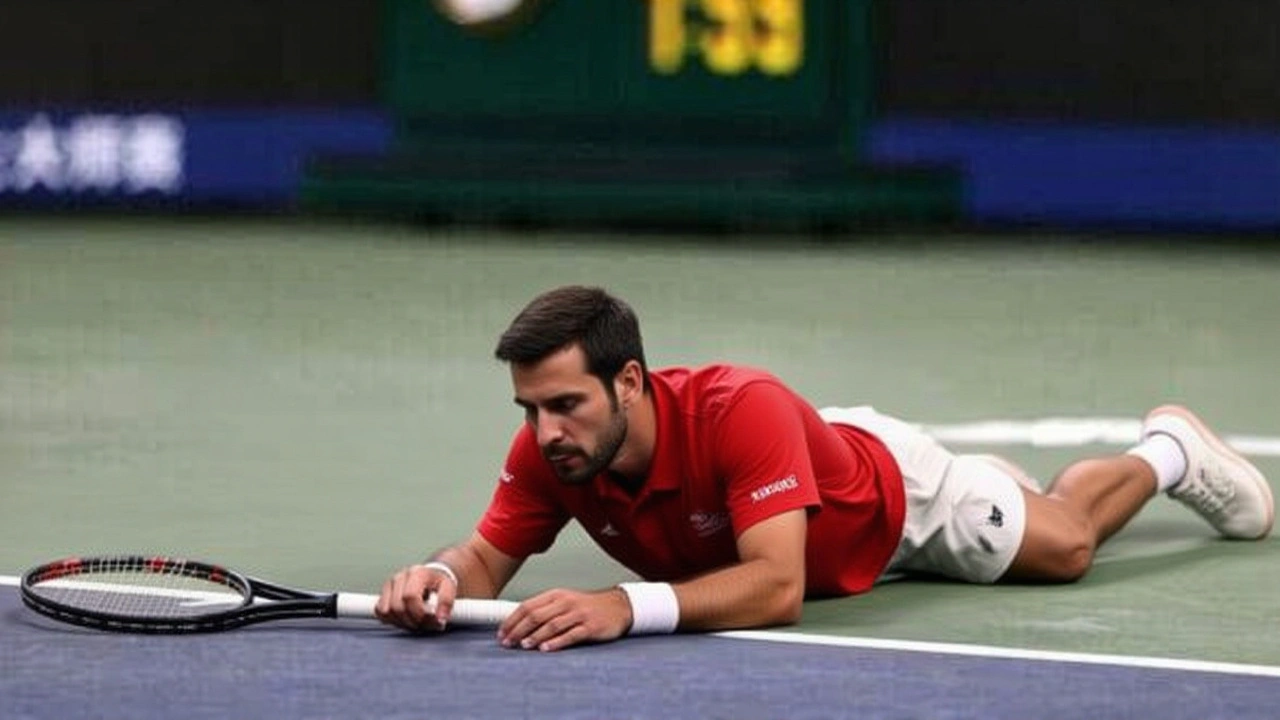When Novak Djokovic doubled over on the court at the Qi Zhong Tennis Center in Shanghai, the scene looked more like a drama than a tennis match. The 38‑year‑old Serbian star, already a 24‑time Grand Slam champion, was forced to vomit twice and limp on a fresh left‑ankle injury while battling Jaume Munar in the round of 16 on October 6, 2025. The reason? heat and humidity that hovered near 80 percent for the entire week.
Brutal conditions turn Shanghai into a pressure cooker
The Shanghai Masters is an ATP 1000 event that usually draws the sport’s elite, but this year the tournament turned into a test of endurance. The Qi Zhong Tennis Center’s outdoor courts faced direct sun from 12 p.m. to 6 p.m., and the relative humidity—often quoted at 78‑82 percent—made every rally feel like a marathon. Even seasoned players whispered about the “biological” toll, a phrase Djokovic used during his post‑match interview.
According to the tournament’s official weather log, temperature peaked at 32 °C (90 °F) on both October 5 and 6, with dew points staying high enough to make sweat feel like a thin veil that never evaporated. In contrast, the 2022 Shanghai edition saw average humidity of 55 percent, a difference that explains why several players, including Italy’s Jannik Sinner, retired early.
Match‑by‑match breakdown: From Hanfmann to Bergs
Djokovic’s campaign began with a straight‑sets win over Germany’s Yannick Hanfmann on October 5. He praised Hanfmann’s “incredible” start but warned that the conditions would “weather the storm” for anyone on court.
In the round of 16, the Serbian faced Spain’s Jaume Munar. Early in the match Djokovic’s forehand slipped on a damp patch, and he crumpled, vomiting between points. He later admitted that the combination of humidity and a rising heart rate made his stomach “turn upside down.” The physical drama didn’t stop there: a sudden twist while chasing a down‑the‑line backhand left him with a sprain to his left ankle. Despite the pain, he edged Munar 7‑5, 6‑4.
The next day, the exhausted champion faced Belgium’s Zizou Bergs. Djokovic continued to double over between long rallies, the ankle throbbed with each short step, yet his serve stayed lethal. He sealed the quarter‑final 6‑3, 7‑5, becoming the oldest ATP 1000 semi‑finalist in history at 38.
Medical concerns and the wave of withdrawals
Beyond Djokovic, the tournament’s medical team reported a surge in heat‑related cases. In addition to Sinner’s retirement on October 5, Spain’s Carlos Alcaraz withdrew pre‑tournament citing a lingering foot issue, though many suspect the weather played a role. The ATP’s official statement was muted, noting only that “player safety remains a top priority.”
Djokovic’s own medical staff applied ice and compression to the ankle after the Munar match and kept a cross‑training regimen in place. By the Bergs match, a taping technique allowed the Serbian to continue competing, but the team warned that “any sudden movement could exacerbate the sprain.”

What the numbers say: A statistical lens on the week
- Average humidity during the tournament: 80 % (vs. 55 % in 2022).
- Maximum temperature recorded: 32 °C (90 °F).
- Players who retired or withdrew due to heat: 4 (including Sinner, Alcaraz, two unnamed qualifiers).
- Djokovic’s win‑loss record in extreme heat (last 5 years): 12‑3.
- Age record: 38 years, 101 st ATP title pursuit.
These figures illustrate why the Shanghai Masters this year will be referenced in future discussions about tournament scheduling and player welfare.
Looking ahead: Semi‑final showdown with Valentin Vacherot
The next opponent for Djokovic is Monegasque qualifier Valentin Vacherot, ranked 204th—a ranking that makes him the lowest‑seeded Masters semi‑finalist in 26 years after his upset over Denmark’s Holger Rune. Vacherot has spoken openly about his own battle with the conditions, saying, “I’ve never felt the court like a sauna before.”
If Djokovic can manage his ankle and stay hydrated, the Serbian’s experience might outweigh Vacherot’s momentum. Either way, the semi‑final on Thursday, October 9, promises another lesson in endurance as much as skill.
Frequently Asked Questions
How did the extreme humidity affect Djokovic’s performance?
The near‑80 % humidity reduced sweat evaporation, causing faster dehydration and a higher core temperature. Djokovic reported nausea and a sudden ankle sprain, both linked to the body’s struggle to regulate heat under such conditions.
What measures are the tournament organizers taking for player safety?
Officials have increased the number of on‑court cooling stations, provided extra hydration breaks, and instructed medical staff to monitor players closely. However, they have not changed the schedule despite player complaints about the heat.
Why is Djokovic’s ankle injury a concern for the semi‑final?
Ankle sprains limit lateral movement, essential for quick direction changes on hard courts. If the ligament inflammation worsens, it could force Djokovic to retire, ending his historic run at Shanghai.
Who is Valentin Vacherot and why is his semi‑final berth notable?
Vacherot, a 22‑year‑old from Monaco, entered the main draw as a qualifier and climbed to the semi‑final by beating higher‑ranked opponents, including Holger Rune. His 204th ranking makes him the lowest‑seeded Masters semi‑finalist in more than a quarter‑century.
What does this tournament mean for Djokovic’s legacy?
Reaching the semi‑final at 38 under such harsh conditions underscores Djokovic’s longevity and physical resilience. A win would give him his 101st ATP title and cement his status as the oldest player to claim a Masters 1000 title.


Pratap Chaudhary
Hope Djokovic recovers quick.